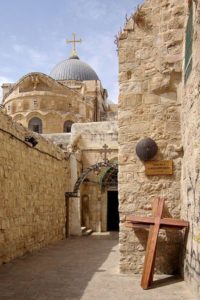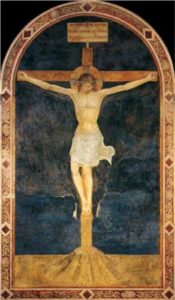
The ninth station of the cross, Via Dolorosa, Jerusalem. In the background you can see the dome of the Church of the Holy Sepulchre, the traditional site of Jesus’ crucifixion.
“Pilate also had an inscription written and put on the cross. It read, Jesus the Nazarene, the King of the Jews. Many of the Jews read this inscription, because the place where Jesus was crucified was near the city; and it was written in Hebrew, in Latin, and in Greek.” (John 19:19-20)
An intriguing passage in the Gospel of John, describing the crucifixion in great detail, including the sign written by Pilate himself and affixed to the cross. The official charge against Jesus seems to have been his challenging the authority of the Romans in Judaea by proclaiming himself, or being proclaimed, “King of the Jews”. It is quite plausible that there was such a sign, proclaiming the crime of the man being punished, as we know of this practice from other Latin historical sources of the period in which criminals are described as wearing signs around their neck, or above their bodies, describing their crime and punishment.
In fact, all four of the Evangelists mention the sign on the cross, but only in John is the sign, called the titulus in Latin, reported as being in three languages. While the discussion rages about what language Jesus himself spoke (maybe more than one?), this verse makes clear the tri-lingual nature of his Palestinian environment. The fresco below, by the Italian Renaissance painter, Fra Angelico, from a Dominican Monastery in Fiesole (1434), illustrates the languages of the inscription itself on the crossbar of the cross. This careful depiction reflects the new interest in ancient languges during the Renaissance. The Latin version mentioned in John, IESUS NAZARENUS REX IOUDAEORM, gives us the acronym INRI, an abbreviation which is found over the cross in so many images. The Greek, Ἰησοῦς ὁ Ναζωραῖος ὁ Βασιλεὺς τῶν Ἰουδαίων = Jesus the Nazaraean, the King of the Jews, gives rise to an argument between the Jews and Pilate in the following verses in John:

Fra Angelico, from a Dominican Monastery in Fiesole (1434)
“So the High Priests of the Jews kept saying to Pilate, ‘Do not write The King of the Jews, but He said I am King of the Jews.’ But Pilate answered, “What I have written, I have written.” (John 19:21-22)
What upsets the High Priests? Here is a point of Greek grammar! In English, there is a difference between saying “the book” and “a book”. “The” is called the “definite article”, and it indicates one particular, definite, book. Whereas “a” is the “indefinite article”, and it indicates any book, not yet specified. In Greek, there is also a definite article and it is used in Pilate’s inscription, referring to The King of the Jews, an absolute title. Of course, the High Priests don’t accept this title for Jesus; they are only willing to accept the fact that he could have called himself A King of the Jews, perhaps one of many people taking this title upon themselves. It is very insightful of John, both in terms of Jewish psychology, the Palestinian linguistic environment, and in his understanding of Greek grammar! Again, he is set apart from the synoptic gospels in this description of the cross. The Hebrew version given by Fra Angelico is also quite correct: ישוע הנצרי ומלך היהודים = Jesus the Nazarite and the King of the Jews. (hard to see these on the reproduction, but believe me!).
The final illustration is a unique Latin inscription. It is called the Pilate Stone and it is a block of limestone with a carved inscription attributed to Pontius Pilate, prefect of the Roman-controlled province of Judaea during the life of Jesus. The stone was found in 1961 by a team of Italian archeologists and is unique because it is the only universally accepted archaeological find with an inscription mentioning the name “Pontius Pilatus” to date – look at the end of the second line. It was found in the ancient theater built by Herod the Great, in the present-day city of Caesarea, which was the capital of the Province of Judaea at the time that Pontius Pilate was the Roman governor.










[…] [11] Judith Green, The Sign of the Cross, Israel Institute of Biblical Studies, 09-19-14, accessed 08-08-21, https://blog.israelbiblicalstudies.com/jewish-studies/sign-cross-judith-green/ […]
The man that wrote the inscription knew how to write hebrew therefore he knew exactly what he wrote
Judaism and Romanism Similarities. Proprietorships Acquired from the ‘World’.
Journal for the Study of Judaism 41 (2010) 323-365
Beyond Judaisms: Metatron and the Divine Polymorphy of Ancient Judaism(1)
Daniel Boyarin
Department of Near Eastern Studies, 248 Barrows Hall, University of California, Berkeley,
CA 94720-1940, USA boyarin@gmail.com
D. Boyarin / Journal for the Study of Judaism 41 (2010) 323-365 327
“Since the 1970’s it has become fashionable to speak of Judaisms, rather
than of Judaism. To be sure, this move was part of a salutary attempt—
initially on the part of Jacob Neusner (10)—to open up our study of Judaism
to include non-rabbinic religion as part and parcel of Judaism and thus
not to write the history of Judaism as the history of the winners.(11) Having
learned the lessons of that move, I think it is time to move beyond it, seeing
Judaism as the sum of the religious expressions of the Jews.(12) We need”
328 D. Boyarin / Journal for the Study of Judaism 41 (2010) 323-365
“to more clearly distinguish among histories of the Jews, histories of Judaism,
and histories of rabbinic Judaism. Getting clearer on the ways that
these are separate, if obviously imbricated, projects will help to clarify
some confusion (and undoubtedly, perhaps in a salutary way, introduce
new confusion). If we think of “the Jews”—anachronistically from a terminological
point of view—as an ethnonym that includes all the people of
Israel”,(13)
“then Judaism is all of the complex of related and contending religious
forms comprehended by those folks, including the figures of Enoch,
Moses, Jesus, and all.(14) It is all-important, however, to emphasize that
these different religious forms do not necessarily resolve themselves into
separate social groups (and this is not just a failure of our knowledge);
they overlap and interact.”(15)
13) A better term might be, then, Israelites but it is hard to go against convention in such
matters.
[Lumping, clumping, amalgamating dross and calling it pure gold.
Heaping onto Yourselves the sins of Jeroboam.
Since You are claiming to be the Whole Nation of Israel, You may also accept the ‘transgressions’ of the Whole Nation and well as the whole of the ‘retributions’.
Or… stop, doing that.]
“Part and parcel of this genealogy then will
be to show how muddy are the lines in the sand that supposedly divide
rabbinic Judaism from its others, including but not limited to that form
of Judaism that eventually is called Christianity”. [from page 328]